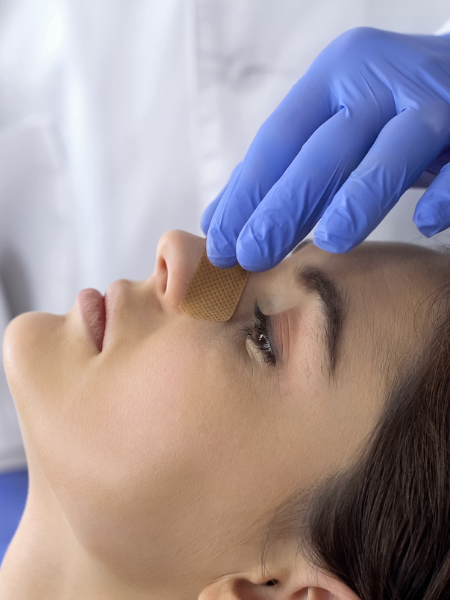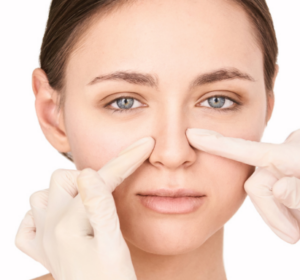
Rhinoplasty, often referred to as a nose job, is a surgical procedure that can profoundly impact your facial appearance and, in some cases, your overall well-being. The choice between open and closed rhinoplasty techniques is a critical decision that every prospective rhinoplasty patient must make. This choice affects the surgical outcome and determines the extent of scarring, recovery time, and potential risks involved.
This comprehensive guide explores the nuances of open and closed rhinoplasty techniques to help you make an informed decision that aligns with your aesthetic and functional goals. By the end of this article, you will clearly understand the pros and cons of both approaches, as well as the factors that should influence your choice.
Open rhinoplasty is a surgical technique in which the surgeon makes a small incision across the columella, the tissue strip separating the nostrils. This incision allows the surgeon to lift the skin and access the underlying structures of the nose, providing a clear view and greater control during the procedure.
Enhanced Visibility: The open approach offers the surgeon an unobstructed view of the nasal structures, enabling precise modifications and higher control over the outcome.
Complex Procedures: Open rhinoplasty is particularly suitable for complex cases involving significant nasal framework alterations.
Improved Surgical Accuracy: The surgeon can make more accurate adjustments with improved visibility, leading to a more tailored and refined result.
Visible Scarring: The small incision across the columella may leave a small scar, although it typically heals well and becomes inconspicuous over time.
Prolonged Swelling: Open rhinoplasty may result in slightly more post-operative swelling compared to the closed technique due to the greater surgical exposure.
Closed rhinoplasty is a less invasive technique that does not require an external incision. Instead, the surgeon makes all the necessary incisions inside the nostrils, making it a more discreet option.
No Visible Scarring: One of the most significant advantages of closed rhinoplasty is the absence of external scarring. All incisions are hidden inside the nostrils.
Faster Recovery: Closed rhinoplasty typically involves a shorter recovery period, as there is less surgical trauma and reduced swelling.
Minimal Disruption: This technique is well-suited for patients seeking minor to moderate adjustments without extensive alterations to the nasal framework.
Limited Visibility: The closed approach may limit the surgeon’s visibility and access, making it less ideal for complex or intricate procedures.
Less Control: Surgeons may have slightly less control over the surgical outcome, which can impact the precision of the modifications made.
 Before deciding between open and closed rhinoplasty, it’s crucial to identify your specific aesthetic and functional goals. Your goals will play a pivotal role in determining the most suitable technique for your needs.
Before deciding between open and closed rhinoplasty, it’s crucial to identify your specific aesthetic and functional goals. Your goals will play a pivotal role in determining the most suitable technique for your needs.
Identifying Desired Changes: Make a list of the specific changes you want to achieve through rhinoplasty. Do you wish to reduce the size of your nose, refine the tip, or correct a deviation?
Technique Alignment: Consider how your goals align with the open or closed techniques. Open rhinoplasty may be more appropriate if your goals are complex, such as extensive reshaping or structural adjustments. For more subtle changes, closed rhinoplasty could be the better choice.
Rhinoplasty is not just about enhancing the aesthetics of your nose; it can also address functional issues. Balancing cosmetic and functional concerns is essential when deciding on the surgical approach.
Aesthetic Concerns: Cosmetic improvements focus on the appearance of your nose, such as size, shape, and symmetry.
Functional Issues: Functional improvements address problems like breathing difficulties, deviated septum, or other structural issues that affect nasal function.
The surgeon’s experience and expertise significantly influence the choice between open and closed rhinoplasty. When selecting a surgeon for your procedure, consider the following factors:
Credentials: Ensure that your surgeon is board-certified and has specific experience in rhinoplasty.
Portfolio: Review the surgeon’s before-and-after photos to evaluate their skill and ability to achieve the desired results.
Patient Testimonials: Read reviews and testimonials from previous patients to gauge their satisfaction with the surgeon’s work.
Questions to Ask: During the consultation, ask the surgeon about their approach and why they recommend open or closed rhinoplasty for your case.
Recovery experiences and scarring concerns are essential aspects to consider when choosing between open and closed rhinoplasty.
Recovery Time: Closed rhinoplasty typically involves a shorter recovery period, with less swelling and discomfort. Open rhinoplasty may require more time for swelling to subside.
Scarring: While open rhinoplasty leaves a small external scar, closed rhinoplasty is scarless from the outside. However, the extent of scarring is generally minimal and fades over time.
The choice between open and closed rhinoplasty techniques influences the surgical plan and how the procedure is tailored to your specific needs.
Technique-Driven Plan: The chosen technique guides the surgical plan. Open rhinoplasty allows for greater customization, while closed rhinoplasty may be more limited in its scope.
Patient Needs: Discuss your goals and concerns with your surgeon during the consultation. They will help you understand how your goals align with the chosen technique and what can be realistically achieved.
During your consultation with a board-certified plastic surgeon, it is crucial to discuss the choice between open and closed rhinoplasty. Here are some factors to consider during this critical conversation:
Goal Alignment: Ensure your surgeon understands your aesthetic and functional goals and can explain how each technique can help you achieve them.
Surgical Plan: Ask the surgeon to outline the surgical plan for your specific case, detailing the adjustments they intend to make.
Scarring Concerns: Discuss your concerns regarding scarring and let the surgeon explain how visible or inconspicuous the scars are likely to be.
There are several myths and misconceptions associated with open and closed rhinoplasty that need to be addressed with accurate information:
Closed Rhinoplasty Is Always Better: While closed rhinoplasty offers advantages like no external scarring and a quicker recovery, open rhinoplasty is often the superior choice for complex cases requiring extensive adjustments.
Open Rhinoplasty Always Leaves a Visible Scar: The scar from open rhinoplasty is typically small and discreet. Over time, it tends to fade and becomes less noticeable.
Closed Rhinoplasty Is Less Invasive: Closed rhinoplasty is less invasive in terms of external incisions, but it may be equally invasive internally, depending on the complexity of the procedure.
Both open and closed rhinoplasty techniques come with their set of potential risks and complications. It’s essential to understand these risks and how they are managed:
Infection: Any surgical procedure carries a risk of infection. Surgeons take precautions to minimize this risk through sterile techniques and post-operative care.
Bleeding: Some bleeding is normal after rhinoplasty, but excessive bleeding can be a complication.
Nerve Damage: Damage to sensory or motor nerves in the nose is rare but can occur. Surgeons are trained to minimize this risk during the procedure.
Dissatisfaction: The most common complication in rhinoplasty is patient dissatisfaction with the results. This risk can be minimized through clear communication with the surgeon and realistic expectations.
Choosing between open and closed rhinoplasty is a significant decision that can impact the outcome of your procedure and your overall experience. The key to making the right choice is a thorough understanding of your goals, the pros and cons of each technique, and the guidance of an experienced and qualified surgeon.
Ultimately, the decision should be based on your unique needs, the complexity of your case, and your surgeon’s recommendations. By considering all the factors discussed in this guide, you can make an informed decision that aligns with your aesthetic and functional goals, ensuring a successful and satisfying rhinoplasty journey. Remember that a consultation with a board-certified plastic surgeon is crucial in this process, as they can provide personalized advice based on your circumstances.